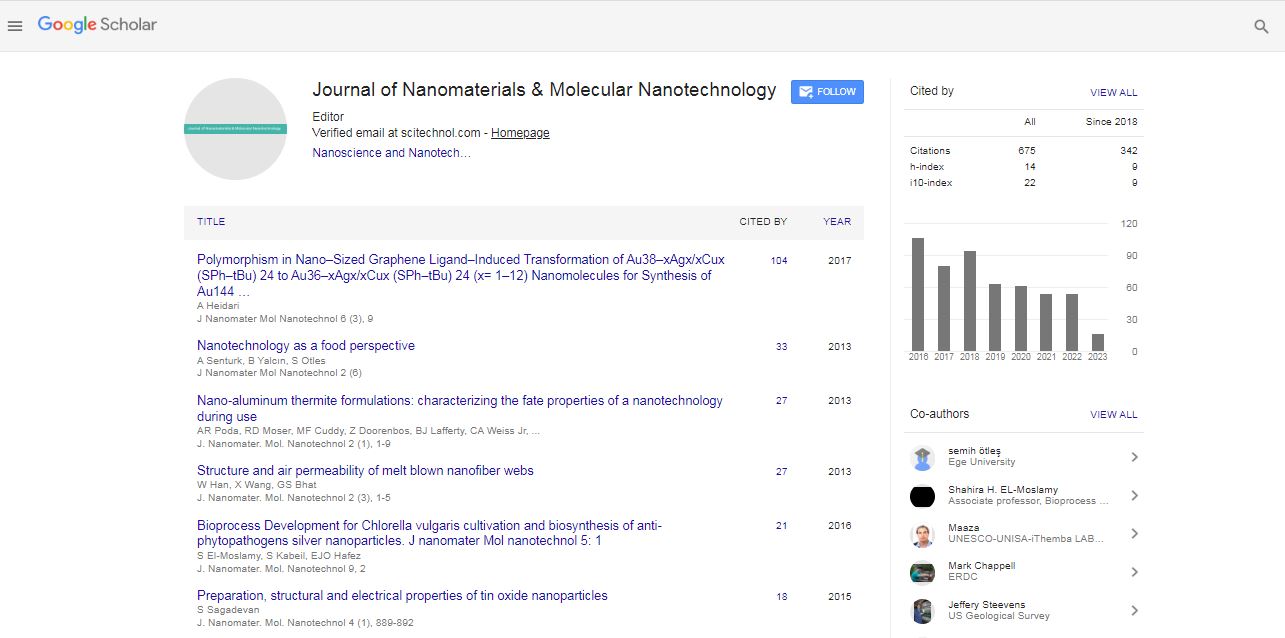Editorial, J Nanomater Mol Nanotechnol Vol: 1 Issue: 1
Nanostructuring Materials towards Conventionally Unachievable Combination of Desired Properties
| Dongyang Li* | |
| University of Alberta, Canada | |
| Corresponding author : Dongyang Li, PhD Professor, Department of Chemical and Materials Engineering, University of Alberta, Edmonton, Alberta, T6G 2V4, Canada E-mail: dongyang.li@ualberta.ca |
|
| Received: June 29, 2012 Accepted: July 02, 2012 Published: July 04, 2012 | |
| Citation: Li D (2012) Nanostructuring Materials towards Conventionally Unachievable Combination of Desired Properties. J Nanomater Mol Nanotechnol 1:1. doi:10.4172/2324-8777.1000e102 |
Abstract
Nanostructuring Materials towards Conventionally Unachievable Combination of Desired Properties
When the size of a particle or the size of grains in a solid is reduced to the nanometer scale, unusual changes in its properties may occur. For example, a nano-sized particle of silica could be electrically conductive while a silver particle may become non-conductive when its size is smaller than 20 nm, which are ascribed to the surface effect and spatial confinement to electrons. Supermagnetism can be obtained when the size of a ferromagnetic particle is reduced to nanometer scale at which only a single domain exists. Such variations in property with object’s dimensional reduction at nanometer scale provide great opportunities to tailor materials for superior properties that cannot be achieved using conventional techniques.
| When the size of a particle or the size of grains in a solid is reduced to the nanometer scale, unusual changes in its properties may occur [1-3]. For example, a nano-sized particle of silica could be electrically conductive while a silver particle may become non-conductive when its size is smaller than 20 nm, which are ascribed to the surface effect and spatial confinement to electrons. Supermagnetism can be obtained when the size of a ferromagnetic particle is reduced to nanometer scale at which only a single domain exists. Such variations in property with object��?s dimensional reduction at nanometer scale provide great opportunities to tailor materials for superior properties that cannot be achieved using conventional techniques. In particular, some properties are opposite to each other and cannot be improved simultaneously using conventional methods. Nanotechnology has made this achievable. | |
| As an example, for mechanical and tribological applications, materials with both high hardness and high toughness are desired. However, using various strengthening mechanisms and heat treatments, we may enhance one but at expense of the other. It is hard to improve both simultaneously, which is however achievable when the materials are nanocrystallized [4]. A nanocrystalline metal with its grain size in the range of 10 nm could be several times harder and tougher than its microcrystalline counterpart. High-density grain boundaries in a nanocrystalline copper provide many more barriers to the movement of partial dislocations and associated stacking fault extension as illustrated in Figure 1A. On the other hand, grain boundaries are also a source for emission of dislocations as shown in Figure 1B, thus leading to enhanced ductility and toughness. Grain boundary sliding in a nanocrystalline metal could also improve the ductility and toughness. The high-density grain boundaries in a material may thus result in an optimal combination of high hardness and high toughness. | |
| Figure 1: Functions of grain boundaries, e.g., in copper: (A) grain boundaries (marked by yellow dashed lines) block the movement of partial dislocations and extension of associated stacking faults (marked in blue). Domains in red represent vacancies and other types of defects. (B) A Cu crystal containing two grain boundaries under a horizontally applied tensile force. Defects are generated at one the grain boundaries and then extended under the external force. Grain boundaries are sites favoring emission of dislocations and stacking faults. | |
| Another example is related to bacterial biofilm control by surface nanocrystallization for medical implants. Foreign objects implanted in human body are favorable sites for the formation of bacterial biofilms that may cause chronic infections. Incorporating anti-bacteria such as Ag into the implants helps kill bacteria but this leads to the galvanic effect thus increased corrosion in the physiological environment. Since nanocrystallization can effectively not only lower the surface electron activity and consequently the affinity for bacteria (Figure 2) but also improve the passivation capability of passive alloys [5], incorporation of Ag into the surface layer of metallic medical implant materials such as stainless steel combining with surface nanocrystallization helps to gain enhanced bacterial killing capability while maintaining desired corrosion resistance as demonstrated in Figure 3 [6]. The decreased affinity for bacteria and increased corrosion resistance by surface nanocrystallization are attributed to promoted chromium diffusion along high-density grain boundaries. | |
| Figure 2: (A) Surface nanocrystallized stainless steel achieved by sandblasting and subsequent recovery at different temperatures, 200, 250, 300, 350 and 400C, resulting in grain sizes of 31, 42, 50, 85 and 105 nm, respectively, as shown in AFM images (a) â�?�? (e). The last AFM image comes from an original sample without surface nanocrystallization (grain size: ~ 10�?µm). (B) Counting of bacteria on the nanocrystallized and original samples. S.B. denotes a sample experienced sandblasting without recovery treatment (i.e. only plastically deformed). | |
| Figure 3: (A) Incorporation of Ag into stainless steel surface makes the steel more susceptible to corrosion due to the galvanic effect, which can however be suppressed by surface nanocrystallization, which effectively increases the passivation capability and corrosion resistance. (B) Ag incorporation and nanocrystallization further reduce the bacterial counting due to the bacteria killing capability of Ag and reduced affinity for bacteria with minimized corrosion resulting from the surface nanocrystallization. | |
| ��?Nanomaterials� has been a hot topic since two decades ago and both science and engineering communities keeps being continuously full of enthusiasm for nanomaterials technology due to its great success. With more involvement of materials design and manipulation at molecular level, revolutionary breakthrough in nanomaterials technology is highly foreseeable. | |
References |
|
|
|




